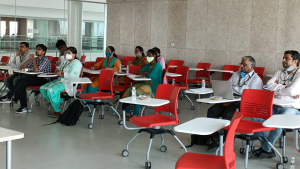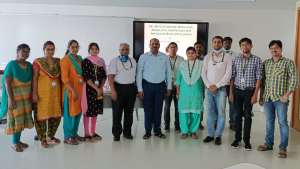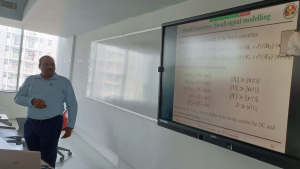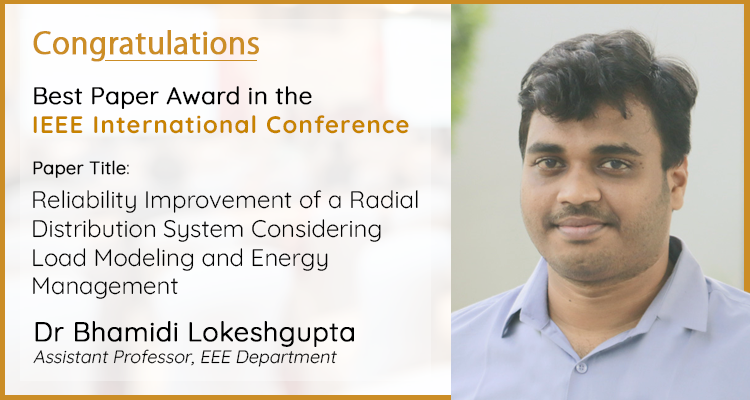Guest Lecture on “DC-DC Converters: Operation, Modelling and Control for Solar and Wind Applications”
The Department of Electrical and Electronics Engineering at SRM University-AP organized a guest lecture titled “DC-DC Converters: Operation, Modelling and Control for Solar and Wind Applications” on December 3, 2021, at 11.00 am IST as part of the Departmental Lecture Series.
An eminent resource person, Dr. Ravindranath Adda, Assistant Professor, Department of Electrical and Electronics Engineering, IIT Guwahati, delivered the intriguing talk as the guest lecture. Many undergraduate students of EEE, research scholars and faculty members of SRM University-AP attended the riveting session.
In his lecture, Dr Adda discussed about the importance of DC-DC converters for solar PV and Wind power applications and emphasized the different non-isolated and isolated converter topologies. He also explained the output power variation of the solar PV or wind turbine as a function of weather conditions, and hence the requirement of DC-DC converters and storage systems to transfer the energy from non-conventional energy sources.
Finally, he discussed about the research scope of DC-DC converters, to increase gain, expedite efficiency, reduce the bulk, dynamic modelling, and large scale and small-scale modelling of DC-DC converters.
The lecture concluded with an energetic note with all the participants looking forward to putting to use all the knowledge and information that they had acquired because of it.
- Published in Departmental News, EEE NEWS, News
Dynamic economic and emission dispatch with renewable energy integration
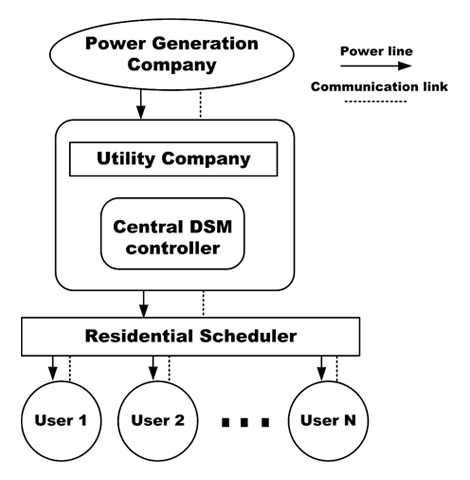 Nowadays, the energy demand of the present electrical power industry is increasing exponentially, and most of the electricity production depends on fossil fuel resources. A research paper titled “Dynamic Economic and Emission Dispatch with Renewable Energy Integration Under Uncertainties and Demand Side Management”, published by Dr B Lokeshgupta, Assistant Professor, Department of Electrical and Electronics Engineering, SRM University-AP, Andhra Pradesh, answers some of the pertinent questions regarding reducing the environmental pollution level.
Nowadays, the energy demand of the present electrical power industry is increasing exponentially, and most of the electricity production depends on fossil fuel resources. A research paper titled “Dynamic Economic and Emission Dispatch with Renewable Energy Integration Under Uncertainties and Demand Side Management”, published by Dr B Lokeshgupta, Assistant Professor, Department of Electrical and Electronics Engineering, SRM University-AP, Andhra Pradesh, answers some of the pertinent questions regarding reducing the environmental pollution level.
Integration of renewable energy resources (RERs) along with demand-side management (DSM) is almost inevitable in the present scenario to meet the growing energy demand with minimum environmental pollution. This work proposes a combined model of dynamic economic and emission dispatch (DEED) and DSM to integrate renewable energy resources (RERs). In this analysis, the DSM load-shifting scheme is incorporated with the DEED problem to obtain the generation side operational benefits as well as the reduction in environmental pollution level. In this study, various smart home appliances and their complex constraints are included in the DSM load shifting process. The variability and stochastic nature of the load demand and RERs such as solar, wind are modelled with Normal, Beta, and Weibull distribution functions, respectively. The proposed model is implemented in both deterministic and stochastic approaches with the help of the non-dominated sorting genetic algorithm (NSGA-II) and the Monte Carlo Simulation (MCS) approach. In the stochastic model, the MCS approach appropriately handles the uncertainties of system load demand and RERs. Four different case studies are carried out in the simulation analysis to show the impacts of RERs and DSM integration on the traditional DEED problem.
Meeting the excessive energy demand with the minimum environmental pollution is a challenging task. The integration of RERs such as wind and solar into the grid is one of the superior solutions for this issue. However, the variability and uncertainty of the RERs bring challenges to the power system operation. Energy management schemes such as demand-side management (DSM) methods can help the power industry address the challenges of RERs integration. That is why the combination of renewable energy integration and DSM is one of the key solutions in the smart grid environment to meet the increased energy demand with the lowest possible energy cost and minimum pollution level. The RERs and DSM combination gives several financial, environmental, and technical benefits to the power industry along with a better system operation.
The dynamic economic and emission dispatch (DEED) is one of the widely adopted tools in the operation and planning of power systems. Both DEED and DSM are the essential tools in the smart grid environment for efficient energy management with the concern of economic and environmental aspects. The DEED’s primary task is to obtain the optimal scheduling of generators with minimum cost and emission for the given load demand. At the same time, the DSM’s primary goal is to improve the optimal values of system objective functions by shifting or managing the controllable loads of consumers. This work introduces a combined stochastic optimisation model of DEED and DSM scheme with the integration of solar and wind energy to show how DSM and RERs bring benefits to a generation company, and also to get better optimal operation cost and emission values simultaneously. The DSM load-shifting scheme is implemented in this study with the help of 10,000 active residential consumers. The effectiveness of the proposed combined model has been tested on a system of six thermal generating units, one wind-powered generator, and one solar-powered generator. The MCS approach and NSGA-II method are used in this paper to solve the proposed stochastic combined DEED and DSM optimisation model.
From the overall analysis, it is recognized that the implementation of the DSM load-shifting scheme along with RERs integration is essential for future smart grids to improve the financial savings of generation companies as well as to reduce the environmental pollution level. The paper is written in collaboration with Dr S Sivasubramani, Associate Professor, Department of Electrical Engineering, Indian Institute of Technology, Patna.
In future, the proposed DSM optimisation can be extended with the inclusion of a neighbourhood power-sharing model in the environment of multiple smart home consumers and prosumers. The proposed DSM model can also be integrated with the distribution network planning and operation problems to enhance the financial and technical benefits of distribution companies.
- Published in EEE NEWS, News, Research News
STEM-Research Society Best Paper Award to faculty and undergraduate students
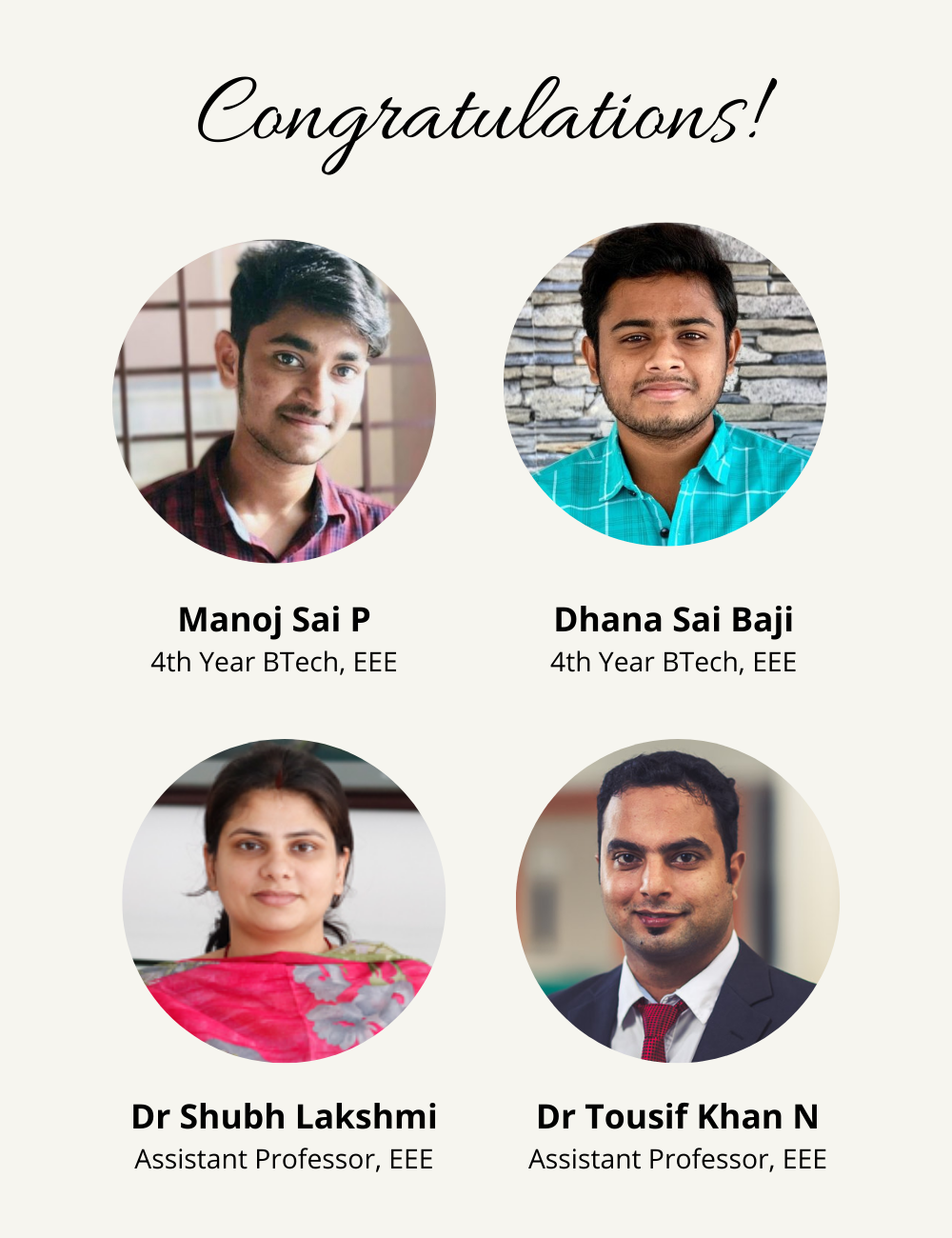 “As an undergraduate student, I initially faced many difficulties selecting the area of interest, analysing and organising a paper, and academic writing skills. The continuous support from faculty at SRM university-AP helped me overcome these issues. This achievement would have been impossible without the support and efforts of my faculty mentors. My heartful gratitude to Dr Shubh Lakshmi madam and Dr Tousif Khan N sir for their kind support and encouragement in research work. I am grateful to start my research career under their guidance. Also, the management encourages and supports us every time in every possible way by providing scholarships.”
“As an undergraduate student, I initially faced many difficulties selecting the area of interest, analysing and organising a paper, and academic writing skills. The continuous support from faculty at SRM university-AP helped me overcome these issues. This achievement would have been impossible without the support and efforts of my faculty mentors. My heartful gratitude to Dr Shubh Lakshmi madam and Dr Tousif Khan N sir for their kind support and encouragement in research work. I am grateful to start my research career under their guidance. Also, the management encourages and supports us every time in every possible way by providing scholarships.”
–Pendem Manoj Sai
A paper titled “Exhaustive Search Approach to Place PV in Distribution Network for Power Loss Minimization” has been awarded STEM-Research Society Best Paper Award in the recently held conference, Soft Computing: Theories and Applications (SoCTA)-2021, at the Indian Institute of Information Technology, Kota on the dates December 17-19, 2021. The authors of the paper are- P Manoj Sai, M Dhana Sai Baji, Dr Shubh Lakshmi, and Dr Tousif Khan Nizami from the Department of Electrical and Electronics Engineering, School of Engineering and Sciences, SRM University-AP, Andhra Pradesh, India. The paper is selected for publication in Lecture Notes in Networks and Systems, Springer (Indexed in SCOPUS).
This paper proposes an exhaustive search approach to determine the best location and size of PV placement for power loss minimisation of radial distribution networks. In this approach, the network power loss is determined by placing PV in each location, one at a time, and the size of PV in the same location is varied between a set minimum and maximum limits. The combination of location and size of PV, which provide the minimum network power loss, can be the best location and size of PV for power loss minimisation of radial distribution networks. The forward-backwards sweep load flow algorithm with the PV model is used to determine the power loss for each combination of location and size of PV.
The paper was presented by Mr P Manoj Sai, a BTech EEE 4th year student from SRM University-AP, Andhra Pradesh. He is thrilled to receive the best paper award and extended his gratitude to Dr Tousif Khan N, the Head of the Department, and Dr Shubh Lakshmi, Assistant professor in the Department of Electrical and Electronics Engineering, for their continuous guidance. Further, he extended his thanks to the management and Pro Vice-chancellor of SRM University-AP for providing financial support.
- Published in Departmental News, EEE NEWS, News, Students Achievements
Dr B Lokeshgupta received the Best Paper Award
Studies that open new possibilities into some of the gripping issues in the scientific domain have transformed SRM University-AP into the epicentre of cutting-edge research and investigations. We are proud to announce that Dr B Lokeshgupta, Assistant Professor of the Department of Electrical and Electronics Engineering has won the Best Paper Award at IEEE Second International Conference on Power, Control and Computing Technologies ICPC²T 2022 held at NIT Raipur, Chhattisgarh. The paper titled “Reliability Improvement of a Radial Distribution System Considering Load Modeling and Energy Management” was co-authored by Dr S Sivasubramani and Mr. Ram Prakash from IIT, Patna. The research gives new insight into energy management and power consumption patterns.
Abstract of the Research
Increasing energy demand and recent advancements in electrical and distributed generation (DG) technology have made power systems complex. Therefore, the reliability assessment is important for efficient planning and operation of distribution networks. The system reliability can be improved with optimal DG integration and energy management schemes. This work mainly studies the impact of optimal DG planning with an energy management scheme on the reliability of radial distribution network. Usually, the reliability of a power system is evaluated using the distribution system reliability indices which are based on load point and customers. The voltage-dependent load model and time-varying load profile for different load classes are included in this work for pragmatic planning. Particle swarm optimization (PSO) algorithm is used to find the optimal site and size of DG units and optimal scheduling of the shiftable loads. The proposed model of optimal DG allocation with energy management is evaluated with a case-based analysis. The modified IEEE 33-bus distribution system is considered in this model to demonstrate the improvement of reliability and operational parameters. Simulation results verify the efficacy of the model.
About the Research
In recent decades, a high load growth rate and frequently changing power consumption patterns are observed due to urbanization and industrialization. Also, the increasing penetration of renewable-based DG has caused a significant mismatch between power generation and electricity demand pattern. This mismatch introduces reliability and power quality issues with loss of energy and revenue to the utilities in power systems. Thus, various energy management programs are carried out by utilities to encourage consumers to change their load patterns. This paper proposes a reliability improvement technique in a radial distribution system by optimal planning of disperse generation and energy management programme.
Social Implication
The research proposes an offline algorithm for the efficient planning and operation of radial distribution networks. Simultaneous deployment of distribution generation (DG) and energy management system (EMS) makes the network more reliable compared to just DG allocation. Application of DG and EMS also improves other operational parameters of the network like power loss and voltage profile.
In future, the energy management concept can be extended with the inclusion of neighbourhood power-sharing model in the environment of multiple smart home consumers and prosumers.
- Published in Departmental News, EEE NEWS, News, Research News
High gain boost converter fed inverter for better power supply
The Department of Electrical and Electronics Engineering is glad to announce that Dr Ramanjaneya Reddy, Assistant Professor; his students, Mr Rahul Kotana and Ms SK Hima Bindu have published a paper titled “High Gain Boost Converter Fed Single-Phase Sine Pulse Width Modulated Inverter” in the journal ‘International Journal of Renewable Energy Research’ having a Scopus site score of 4.2.
Abstract of the Research
A high gain boost converter fed single-phase voltage source inverter with its control for DC to AC power conversion in uninterrupted power supply and renewable energy applications is presented in this paper. The conventional DC-DC boost converter with a coupled inductor and switched capacitor is utilised to obtain high gain. Further, the output voltage of the inverter is controlled by the sinusoidal pulse width modulation technique. The detailed design and analysis of a high gain boost converter fed single-phase voltage source inverter is presented. The sine pulse width modulation control scheme for the voltage source inverter is also developed and presented. To validate the high gain boost converter fed single-phase voltage source inverter, the simulation model is developed in the LTspice software environment, and the results are validated. The results show high gain boost converter achieves a gain of about 10 and the single-phase voltage source inverter can provide an rms voltage of 228 V without using the step-up transformer. The total harmonic distortion of output current is found to be below 4.
About the Research
Energy is an essential factor for the functioning and economic development of the industrialized world. It plays a key role in our day-to-day life. On the other hand, energy management has become a critical factor for our successive economic prosperity. The energy consumption process frequently needs either DC-AC conversion or AC-DC conversion. The DC-AC conversion finds its major application in uninterrupted power supply (UPS) and renewable energy (RE). To supply during power outages, most UPS systems use batteries, usually lead-acid, as the storage mechanism. The battery is supposed to provide the backup in the absence of the grid supply. However, the voltage provided by the battery alone may not be enough to provide the backup. At first, the battery output power which is DC needs to be converted to AC with the help of an inverter. Apparently, the output of the inverter needs to be stepped up with the help of a step-up transformer to achieve an output of 220V 50Hz. An alternative approach to the same process is by using a power electronic converter called the DC-DC boost converter. The boosting of battery/PV voltage can be achieved with the help of a standard boost converter as shown in Fig. 1(b), or by using a battery capable of supplying higher voltage and a step-up transformer as shown in Fig. 1(a). High power batteries and step-up transformers can be eliminated if a high gain boost (HGB) converter is used instead of a standard boost converter. The HGB converter fed DC-AC conversion system is presented in this paper which eliminates the step-up transformer. The circuit configuration of the proposed work is depicted in Fig. 2.
Practical Implementations of the Research
The DC-AC conversion method proposed is based on the HGB converter fed single-phase SPWM inverter. The proposed model is best suited when a low voltage DC supply is available, and a standard 230V AC output is needed to deliver the load. The detailed design and analysis of the HGB converter are carried out, and the gain of the converter is achieved at around 10, which is very high compared with conventional boost converter topologies. A unipolar SPWM control scheme is developed in LTspice to control the single-phase VSI. The simulation results of the complete DC-AC conversion system are in close agreement with the design parameters. Further, the total harmonic distortion of the output current waveform is around 4% which is well below the international standards. In addition, the complete model consisting of both HGB converter and single-phase VSI are successfully simulated for an input of 36 V DC and produced an rms output voltage of 228 V.
In future, the DC-AC conversion method based on a high gain boost converter can be extended with the three-phase voltage source inverter with electric drive applications.
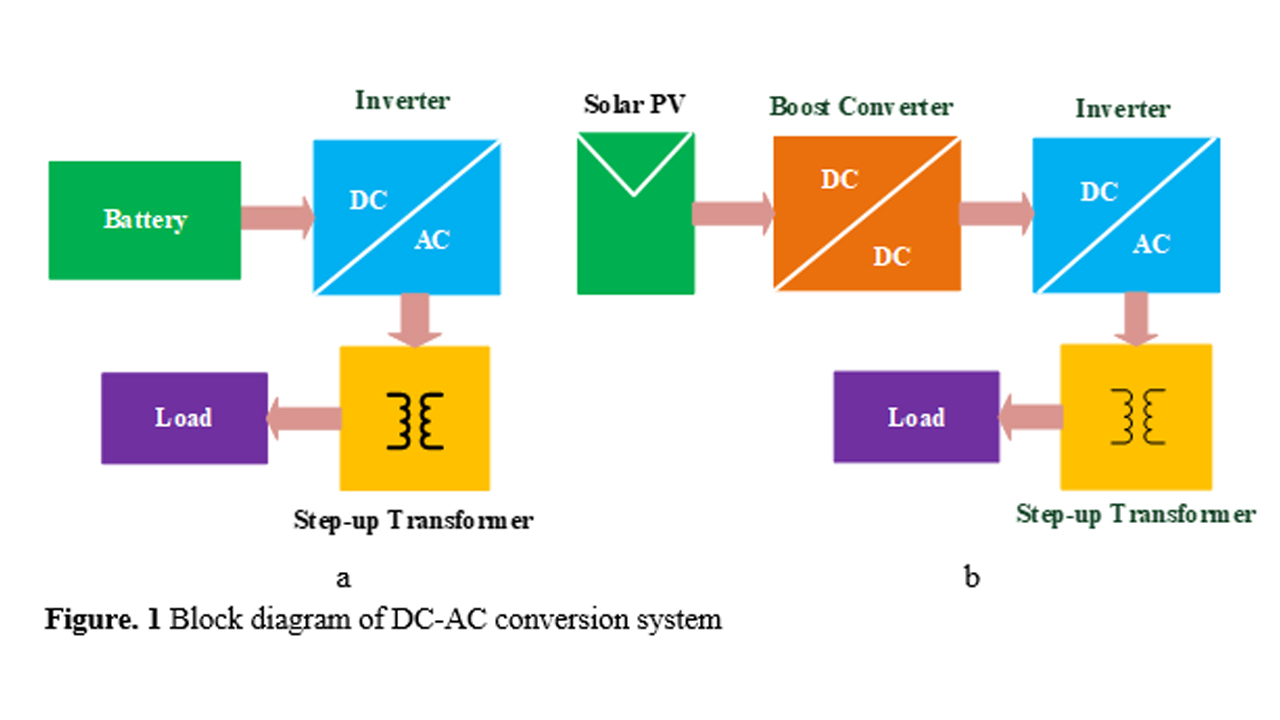
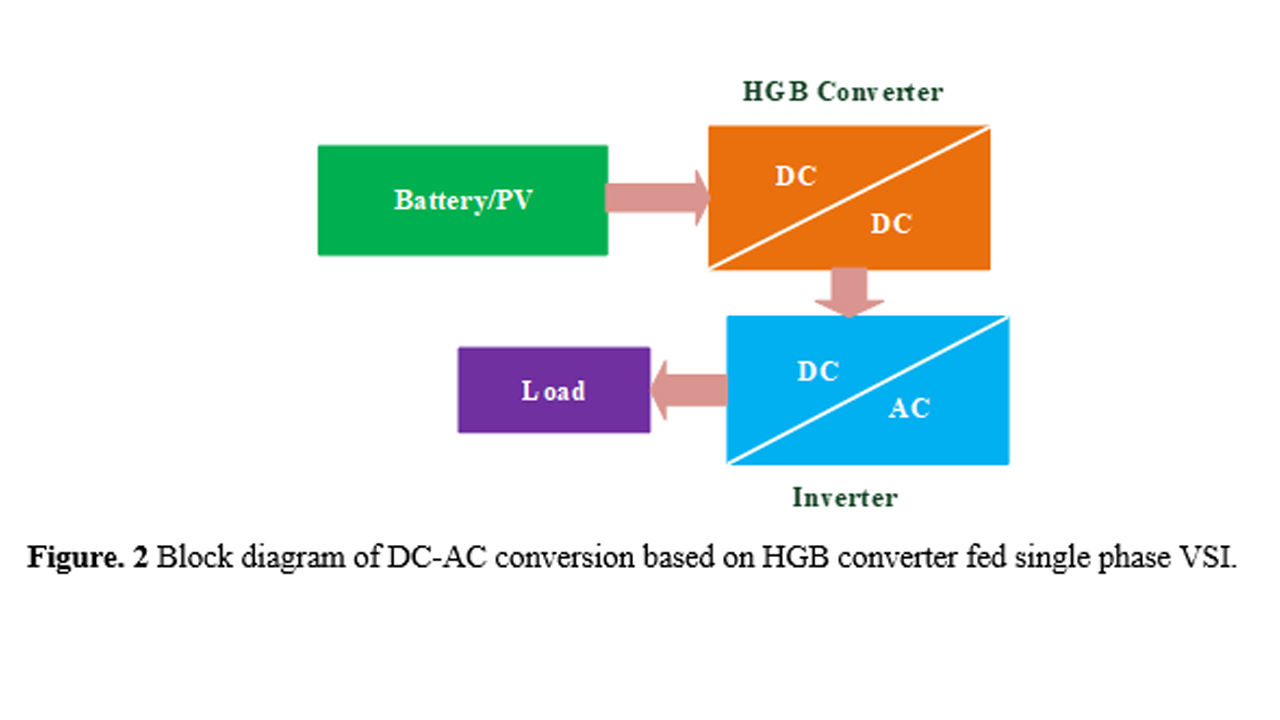
- Published in Departmental News, EEE NEWS, News, Research News
Guest Associate Editor in ‘Frontier in Control Engineering’ journal
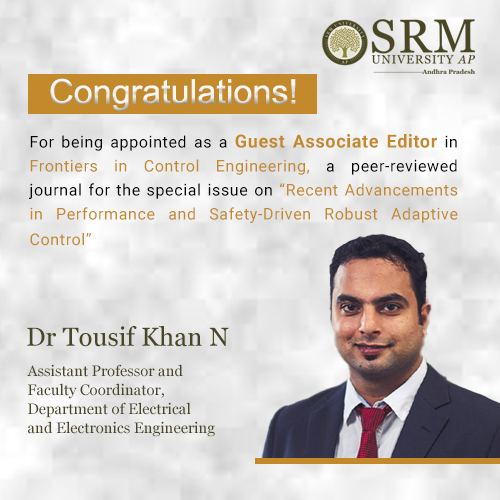 The Department of Electrical and Electronics Engineering is Proud to inform you that Dr Tousif Khan N, Assistant Professor, and Faculty Coordinator, has been appointed as a Guest Associate Editor in Frontiers in Control Engineering, a peer-reviewed journal for the special issue on “Recent Advancements in Performance and Safety-Driven Robust Adaptive Control.”
The Department of Electrical and Electronics Engineering is Proud to inform you that Dr Tousif Khan N, Assistant Professor, and Faculty Coordinator, has been appointed as a Guest Associate Editor in Frontiers in Control Engineering, a peer-reviewed journal for the special issue on “Recent Advancements in Performance and Safety-Driven Robust Adaptive Control.”
This Research Topic is intended to give an insight into the latest development regarding the control design and analysis for the nonlinear systems under multiple uncertainties, matched and unmatched disturbances, measurement noises, actuator/sensor faults, and non-smooth nonlinearities. To render a promising control performance under resource-constrained communication networks, state constraints, control constraints, and other related issues are additional design objectives and the focus of this Research Topic.
In conclusion, developing an effective onboard implementable control approach for dynamical systems where safety, performance, uncertainty, and optimality are dealt with concurrently is the main objective of this special issue of the research journal Frontiers in Control Engineering.
- Published in Departmental News, EEE NEWS, Faculty Achievements, News, Research News
Dr Tousif Khan published in Springer Nature
The Department of Electrical and Electronics Engineering is proud to announce that the estimable book of Springer Nature, ‘Soft Computing: Theories and Applications’ has featured three publications by Dr Tousif Khan, Assistant Professor. His publications are part of the book series, Lecture Notes in Networks and Systems (LNNS), Volume 425. The book stimulates discussions on various emerging trends, innovations, practices, and applications in the field of soft computing, ranging from data mining, prediction analysis, control systems, image processing, health care, medicine, agriculture analysis, supply chain management and cryptanalysis etc.
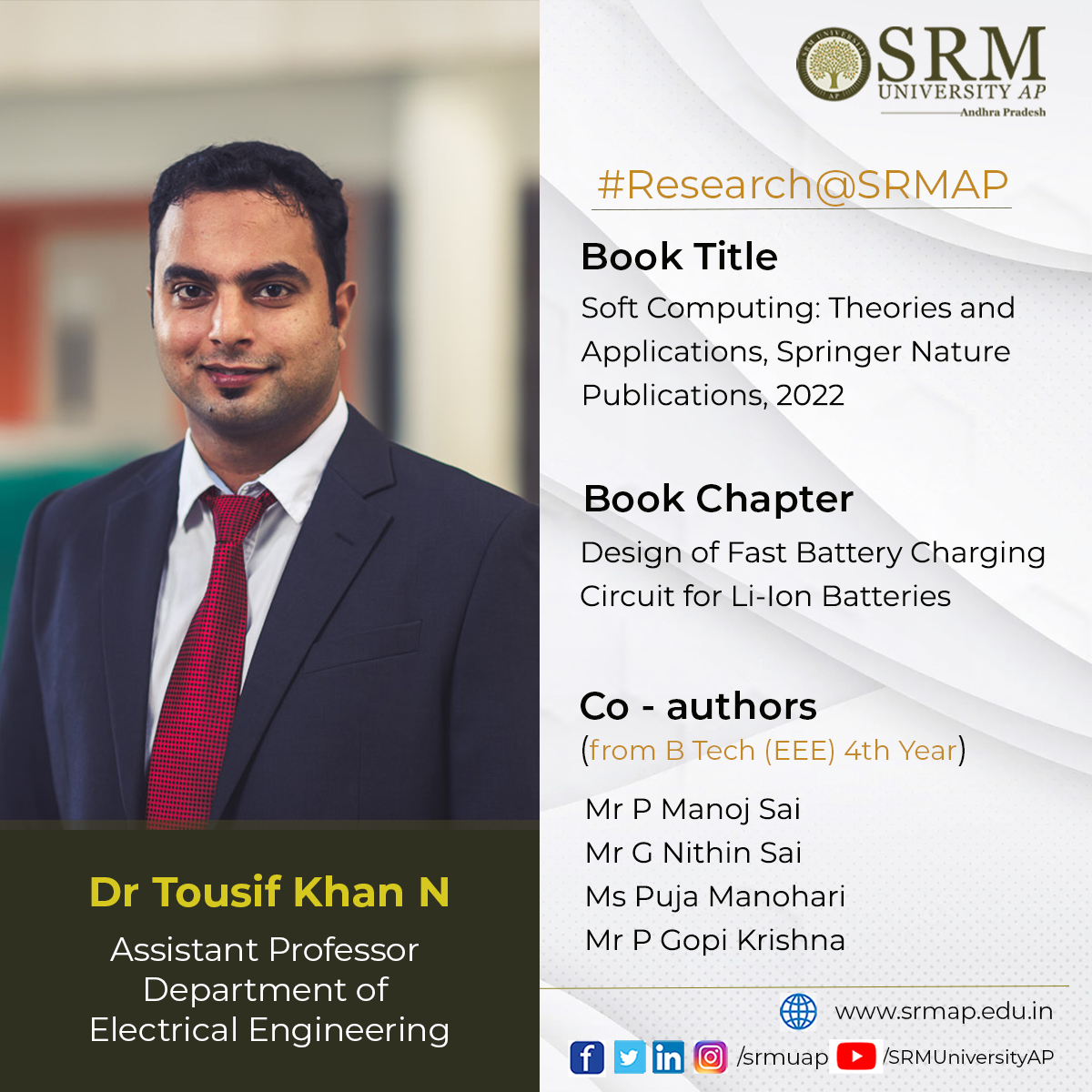 The first chapter titled “Design of Fast Battery Charging Circuit for Li-Ion Batteries” was co-authored by Dr Khan along with the final year EEE students; P Manoj Sai, G Nithin Sai, Puja Manohari, and P Gopi Krishna. In this chapter, a battery charging topology has been designed and developed for the fast charging of Li-ion batteries. The charging circuitry comprises a Proportional-Integral-Derivative (PID) controlled DC-DC buck converter system for reducing the charging time in Li-ion batteries. Battery charging time depends on several factors and the charging current is one of the major criteria. In this work, the buck converter is used to attain a high charging current, besides providing the regulated voltage to the battery. Initially, the AC supply obtained from the mains is converted to DC using an AC-DC rectifier. The rectifier output is further fed to the buck converter to increase the output current of the circuit. The buck converter reduces the output voltage and increases through it.
The first chapter titled “Design of Fast Battery Charging Circuit for Li-Ion Batteries” was co-authored by Dr Khan along with the final year EEE students; P Manoj Sai, G Nithin Sai, Puja Manohari, and P Gopi Krishna. In this chapter, a battery charging topology has been designed and developed for the fast charging of Li-ion batteries. The charging circuitry comprises a Proportional-Integral-Derivative (PID) controlled DC-DC buck converter system for reducing the charging time in Li-ion batteries. Battery charging time depends on several factors and the charging current is one of the major criteria. In this work, the buck converter is used to attain a high charging current, besides providing the regulated voltage to the battery. Initially, the AC supply obtained from the mains is converted to DC using an AC-DC rectifier. The rectifier output is further fed to the buck converter to increase the output current of the circuit. The buck converter reduces the output voltage and increases through it.
The circuit parameters are designed by considering the commercially available Lithium-ion battery LIR18650 as the load with a capacity of 2600 mAh and a nominal voltage of 3.7 V. The considered battery requires a standard charging current of 0.5 A, however, the circuit is designed to provide the rapid charge current of 1.3 A as the output by using the buck converter. The converter is operated in continuous conduction mode and helps in charging the battery under constant current mode. To avoid interruption to the charging current when there is a simultaneous discharge of the battery, further improvement in the closed-loop control action is made by employing a PID controller. Extensive simulation work has been conducted using the MATLAB/Simulink tool. The results obtained suggest there is a significant reduction in charging time under different conditions compared to the conventional method of battery charging.
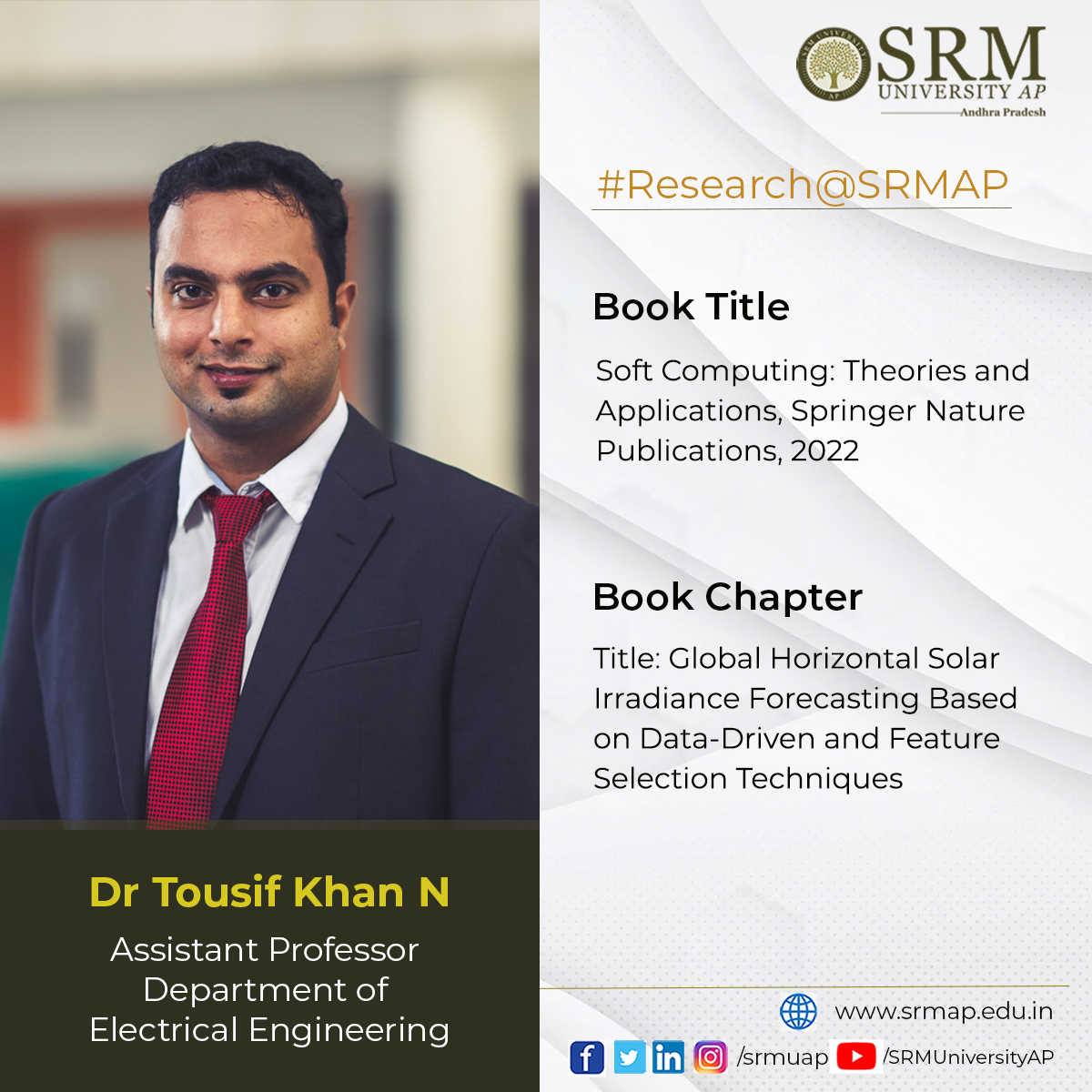 In the chapter, “Global Horizontal Solar Irradiance Forecasting Based on Data-Driven and Feature Selection Techniques”, Dr Khan discusses the need for an accurate solar prediction. It has become an essential part of the renewable energy sector with the rapidly expanding infrastructure of the solar energy system. Over the past decade, various machine learning (ML) algorithms have been used for this purpose. Although the prediction of solar irradiance forecasting has been discussed in many studies, the use of meta-heuristic optimization techniques has not been explored to select features for the forecasting model. This study comprises two meta-heuristic optimization techniques such as simulated annealing (SA) and ant colony optimization (ACO) for feature selection. The results show that feature selection based on meta-heuristics gave better results than models without feature selection.
In the chapter, “Global Horizontal Solar Irradiance Forecasting Based on Data-Driven and Feature Selection Techniques”, Dr Khan discusses the need for an accurate solar prediction. It has become an essential part of the renewable energy sector with the rapidly expanding infrastructure of the solar energy system. Over the past decade, various machine learning (ML) algorithms have been used for this purpose. Although the prediction of solar irradiance forecasting has been discussed in many studies, the use of meta-heuristic optimization techniques has not been explored to select features for the forecasting model. This study comprises two meta-heuristic optimization techniques such as simulated annealing (SA) and ant colony optimization (ACO) for feature selection. The results show that feature selection based on meta-heuristics gave better results than models without feature selection.
Amongst the two optimization methods, ACO outperformed SA with some exceptions. For SA, the declining order of performance observed is extreme gradient boosting (XGBoost), random forest (RF), multilayer perceptron (MLP), decision tree (DT) and support vector regression (SVR), while for ACO the declining order observed is XGBoost followed by MLP, RF, DT and SVR. This manuscript indicates the potential capability of meta-heuristic techniques for accurate prediction of global horizontal irradiance (GHI) given a wide array of feature variables.
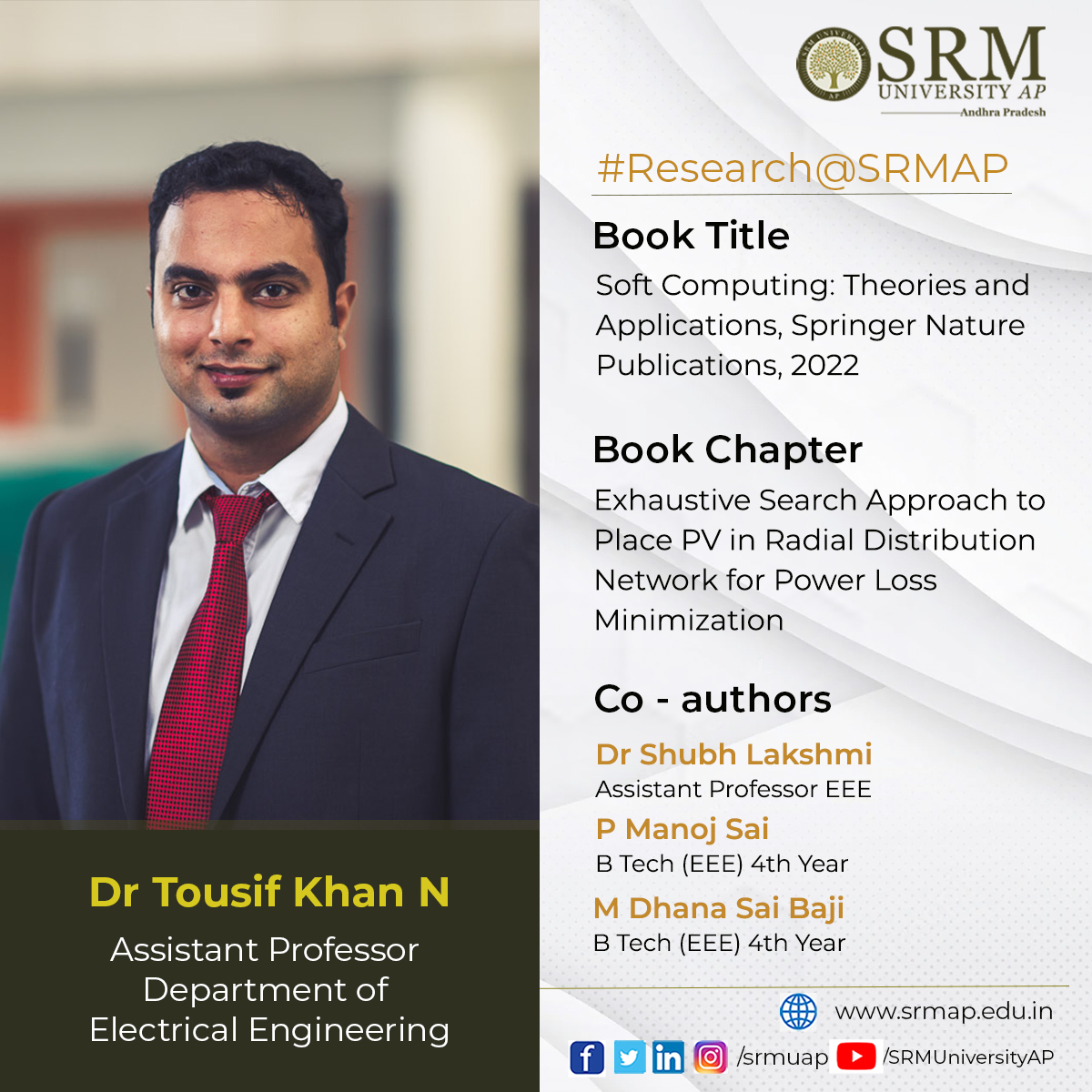 In yet another chapter, “Exhaustive Search Approach to Place PV in Radial Distribution Network for Power Loss Minimization”, co-authored with Dr Shubh Lakshmi, Assistant Professor, and the final year students; P Manoj Sai and M Dhana Sai Baji from the Department of Electrical and Electronics Engineering, an exhaustive search approach to determine the best location and size of PV placement for power loss minimization of radial distribution networks is discussed. In this approach, the network power loss is determined by placing PV in each location, one at a time, and the size of PV in the same location is varied between 10 and 300 kW with an increment of 10 kW.
In yet another chapter, “Exhaustive Search Approach to Place PV in Radial Distribution Network for Power Loss Minimization”, co-authored with Dr Shubh Lakshmi, Assistant Professor, and the final year students; P Manoj Sai and M Dhana Sai Baji from the Department of Electrical and Electronics Engineering, an exhaustive search approach to determine the best location and size of PV placement for power loss minimization of radial distribution networks is discussed. In this approach, the network power loss is determined by placing PV in each location, one at a time, and the size of PV in the same location is varied between 10 and 300 kW with an increment of 10 kW.
The combination of location and size of PV which provides the minimum network power loss can be the best location and size of PV for power loss minimization of radial distribution networks. The forward–backward sweep load flow algorithm is used to incorporate the PV model. The 33-bus radial distribution network is used to demonstrate the approach. The simulation results show that the placement of a suitable size of PV in some specific locations significantly reduces the network power loss.
Publishing the latest advancements in Networks and Systems, The LNNS series will serve as an edifying read for all the researchers and scientists across the globe. Volumes published in LNNS give a deep insight into all aspects and subfields of, as well as new challenges in, Networks and Systems. The series encompasses the theory, applications, and perspectives on the state of the art and future developments relevant to systems and networks, decision making, control, complex processes and related areas, as embedded in the fields of interdisciplinary and applied sciences, engineering, computer science, physics, economics, social, and life sciences, as well as the paradigms and methodologies behind them.
- Published in Departmental News, EEE NEWS, News, Research News
Enhanced dynamic performance in DC-DC converter-PMDC motor combination
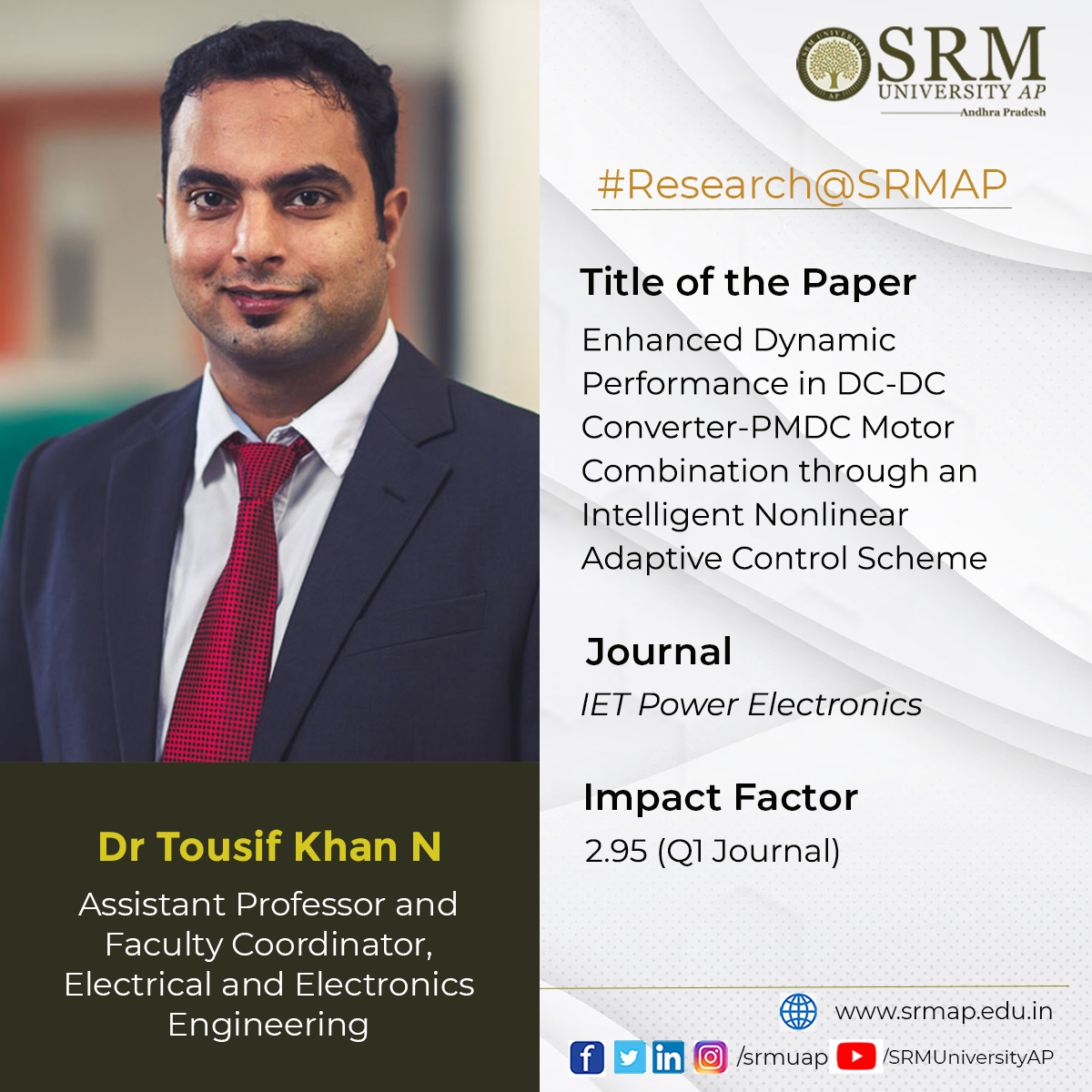 “Enhanced Dynamic Performance in DC-DC Converter-PMDC Motor Combination through an Intelligent Nonlinear Adaptive Control Scheme”, is the latest paper published by Dr Tousif Khan, Assistant Professor of EEE Department at SRM University-AP in the reputed IET Power Electronics (Q1 journal) having an Impact Factor of 2.95.
“Enhanced Dynamic Performance in DC-DC Converter-PMDC Motor Combination through an Intelligent Nonlinear Adaptive Control Scheme”, is the latest paper published by Dr Tousif Khan, Assistant Professor of EEE Department at SRM University-AP in the reputed IET Power Electronics (Q1 journal) having an Impact Factor of 2.95.
Abstract
A novel neuro-adaptive control scheme is proposed in the context of angular velocity tracking in DC-DC buck converter-driven permanent magnet DC motor system. The controller builds upon the idea of backstepping control. The proposed method guarantees a rapid recovery of nominal angular velocity tracking under parametric and non-parametric uncertainties. In order to verify the performance of the proposed neuro-adaptive speed controller, extensive experimentation has been conducted in the laboratory under various real-time scenarios. Results are obtained for start-up, time-varying angular velocity tracking and under the influence of highly non-linear unknown load torque. The performance metrics such as peak undershoot/overshoot and settling time are computed to quantify the transient response behaviour. The results clearly substantiate theoretical propositions and demonstrate an enhanced dynamic speed tracking under a wide operating regime, thus confirming the suitability of the proposed method for fast industrial applications.
- Published in Departmental News, EEE NEWS, Research News
Nature-inspired Seagull Optimisation Approach algorithm
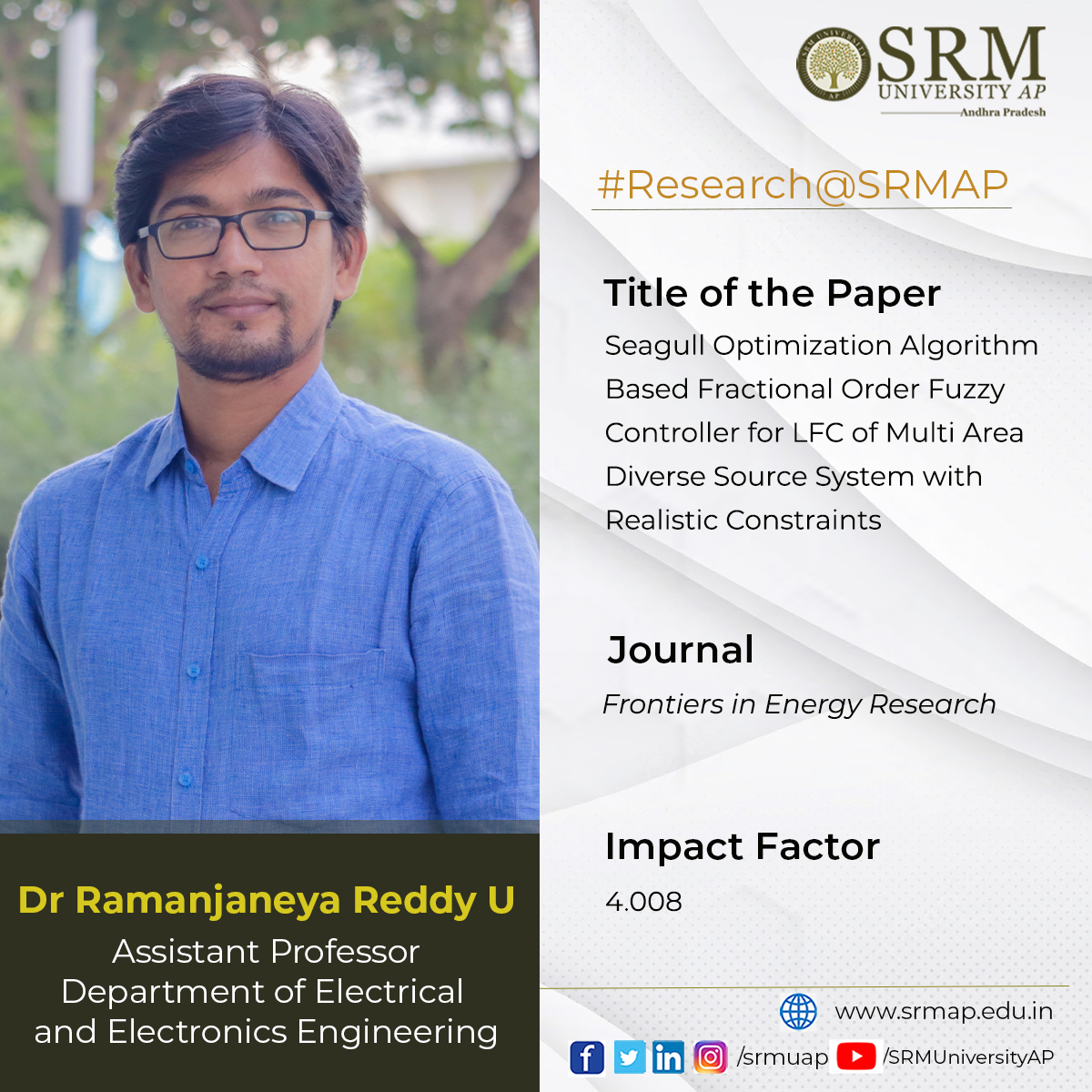 In modern days, the most potent ancillary service is the LFC, especially for controlling and operating interconnected power system networks. The electrical system is becoming more complex due to the integration of several diverse sources generating units to meet the variable load demand. Research in the Department of Electrical and Electronics Engineering is currently working on this area. Assistant Professor Dr Ramanjaneya Reddy recently published a paper titled Seagull Optimization Algorithm Based Fractional Order Fuzzy Controller for LFC of Multi Area Diverse Source System with Realistic Constraints in the Frontiers in Energy Research journal. It is published in the Smart Grids section of the journal with an impact factor of 4.008.
In modern days, the most potent ancillary service is the LFC, especially for controlling and operating interconnected power system networks. The electrical system is becoming more complex due to the integration of several diverse sources generating units to meet the variable load demand. Research in the Department of Electrical and Electronics Engineering is currently working on this area. Assistant Professor Dr Ramanjaneya Reddy recently published a paper titled Seagull Optimization Algorithm Based Fractional Order Fuzzy Controller for LFC of Multi Area Diverse Source System with Realistic Constraints in the Frontiers in Energy Research journal. It is published in the Smart Grids section of the journal with an impact factor of 4.008.
Abstract
This paper initiates the implementation of fractional order (FO) fuzzy (F) PID (FOFPID) controller fine-tuned using a seagull optimisation algorithm (SOA) for the study of load frequency control (LFC). Initially, the SOA tuned FOFPID regulator is implemented to the widely utilized model of dual area reheat-thermal system (DARTS) named as test system-1 in this work for a perturbation of 10% step load (10%SLP) on area-1. Dynamical analysis of the DARTS system reveals the viability of SOA tuned FOFPID control scheme in regulating frequency deviations effectively compared to other control schemes covered in the literature. Later, the presented regulator is implemented in multi-area diverse sources (MADS) system possessing realistic constraints in this paper termed test system-2. The sovereignty of the presented FOFPID controller is once again evidenced with controllers of PID/FOPID/FPID fine-tuned with the SOA approach. Moreover, the effect of considering practical realistic non-linearity constraints such as communication time delays (CTDs) on MADS system performance is visualized, and the necessity of its consideration is demonstrated. Further, AC-DC lines are incorporated with MADS system to enhance the performance under heavy load disturbances and the robustness of the proposed regulatory mechanism is deliberated.
Explanation of the research
The operating point of the generation unit must be altered to keep the real power mismatch (RPM) as minimum as possible. RPM is the exact difference between the amount of real power generated by the generation units and the existing load demand. This RPM is the direct analogy to one of the power full parameters in the interconnected network, frequency. Thus, the minimisation of RPM should be monitored continuously as there will be continuous fluctuations in load demand. This must be done automatically. Otherwise, the real power mismatch may worsen and affect the power system frequency. Frequency regulation must be made with the utmost care; if not, it adversely affects the power system stability. LFC will quickly and automatically accomplish this task.
From the literature on LFC, it is apparent that the optimisation-based controllers significantly handle LFC performance. Hence, applications of new optimisation algorithms for solving realistic power system problems are always welcome. In this regard, this paper implements a new nature-inspired seagull optimisation approach (SOA) algorithm. It is a maiden attempt, especially for power system operation and control of IPS with practical constraints. Until now, the regulators presented by the researchers are tested on linearised and non-linearised power system models without and with integrating renewable energy units. To authenticate the investigative analysis of LFC closer to the nature of the realistic practice, the researchers must adopt the non-linearity constraints with power system models. Constraints of non-linearity like GRC and GDB are considered widely by the researchers and paid less attention to other constraints of CTDs.
In realistic practice, IPS are widely spread and employs numerous sensing and phasor measurement devices. The measured data will be transmitted and received among different devices located at distant places via communication peripherals. Exchange of information won’t be done instantly, and a specific time delay exists. The delay might affect the IPS performance; hence, this paper tried to investigate the predominancy of time delays in coordination with the constraint of GRC. Little work is available on studying LFC with CTDs and is restricted up to the implementation of traditional regulators. Thus, this paper addresses the impact of realistic constraint parameter that is CTDs on IPS performance in coordination with GRC under fuzzy aided FO-based regulator based on the newest optimization algorithm.
Practical implementations of the research
This work considered two different power system networks to assess the FOFPID controller performance. One is DARTS, termed test system-1, and the other is MADS, termed test system-2. DARTS model incorporates thermal units of reheat-type turbines in both areas with equal generation capacities. On the other hand, the MADS system that tests system-2 consists of two areas having Thermal-Hydro-Gas units in area-1, and area-2 comprises Thermal-Hydro-Wind units. The participation factor for each source of generation unit is allocated to achieve smooth load distribution and is considered as 0.6225 for thermal, 0.3 for hydro unit, and a factor of 0.075 for gas/wind unit. The required data to build the DARTS system depicted in Figure 1 and MADS system model depicted in Figure 2 are considered from [13] and [35], respectively. The power system models are designed in the (R2016a) version of MATLAB/SIMULINK.
In the future, there is a lot of scope for assessing the effect of CTDs on LFC performance and the implementation of SOA-based FOFPID for optimising IPS in the restructured environment.
- Published in Departmental News, EEE NEWS, News, Research News
Towards power quality improvement
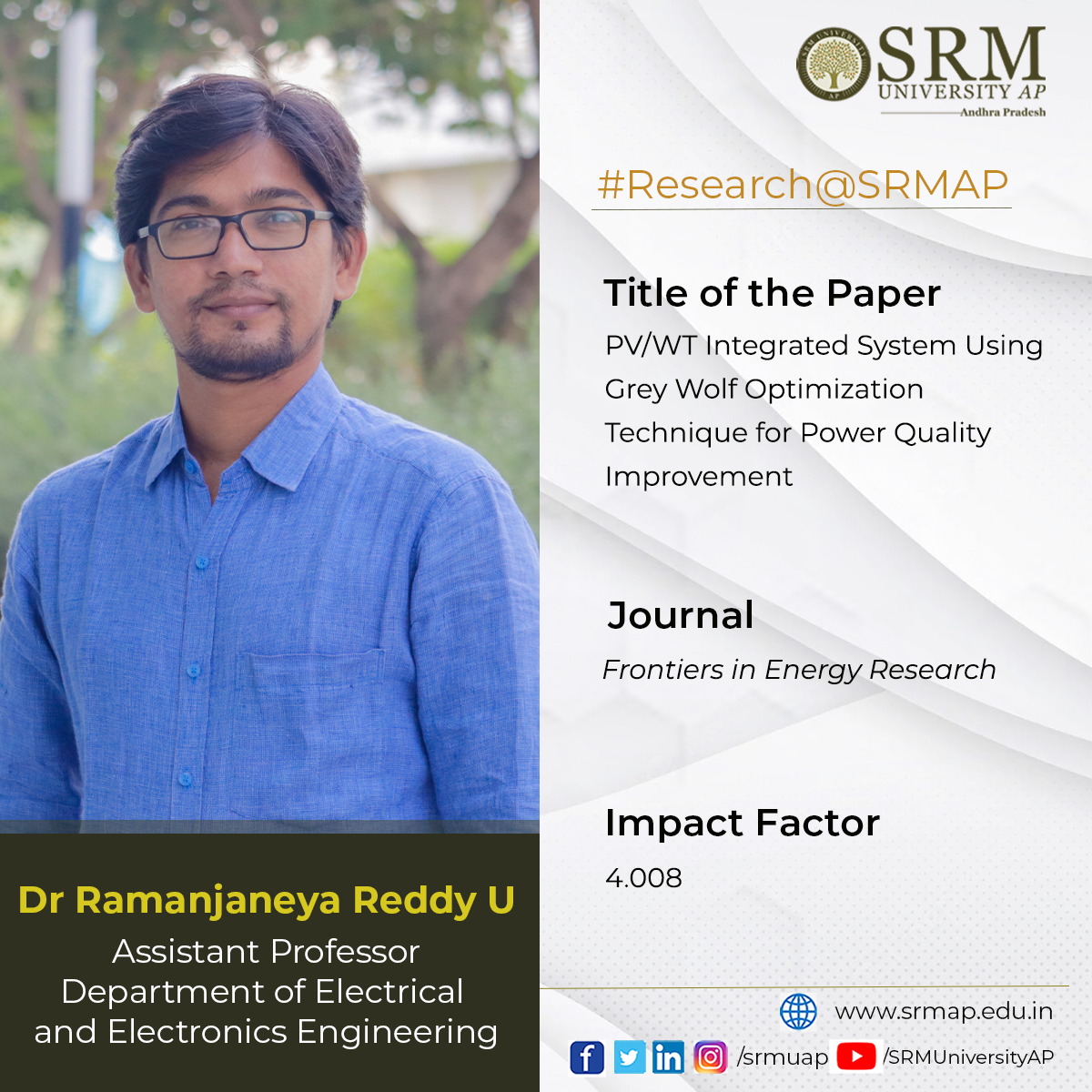 In future, there is a lot of scope for enhancing the power quality using various controllers whose gains are obtained using different optimisation techniques to mitigate several issues. Assistant Professor Dr Ramanjaneya Reddy, Department of Electrical and Electronics Engineering, envisions this tomorrow through his new research paper PV/WT Integrated System Using Grey Wolf Optimization Technique for Power Quality Improvement. The paper is published in the Process, and Energy Systems Engineering section of the Frontiers in Energy Research journal and has an impact factor 4.008. For this research paper, he has collaborated with Assistant Professor Srikanth Goud, Anurag College of Engineering Ghatkesar, Telangana.
In future, there is a lot of scope for enhancing the power quality using various controllers whose gains are obtained using different optimisation techniques to mitigate several issues. Assistant Professor Dr Ramanjaneya Reddy, Department of Electrical and Electronics Engineering, envisions this tomorrow through his new research paper PV/WT Integrated System Using Grey Wolf Optimization Technique for Power Quality Improvement. The paper is published in the Process, and Energy Systems Engineering section of the Frontiers in Energy Research journal and has an impact factor 4.008. For this research paper, he has collaborated with Assistant Professor Srikanth Goud, Anurag College of Engineering Ghatkesar, Telangana.
Abstract
This work presents the integration of renewable energy sources such as PV and wind into the grid. Hybrid shunt active power filter (HSHAPF) is optimised with the grey wolf optimisation (GWO) and fractional order proportional integral controller (FOPI) for harmonic reduction under non-linear and unbalanced load conditions. With the use of GWO, the parameters of FOPI are tuned, effectively minimising the harmonics. The proposed model has effectively compensated the total harmonic distortions (THD) when compared with filter, without filter, with passive filter, active power filter with PI controller, and GWO- FOPI-based controller. The performance of the proposed controller is tested under non-linear and unbalanced conditions. The parameters of the FOPI controller are better tuned with the GWO technique. The comparative results reflect the best results of GWO-FOPI based HSHAPF. The suggested controller is built in the MATLAB/Simulink Platform.
Explanation of the research
Power quality (PQ) problems in the distribution system occur when non-linear loads are used. With the development in semiconductor technology, the modelling and usage of power electronic devices are increasing on the end-user side. Because of the usage of power, electronic devices give rise to many problems like a disturbance in reactive power, poor power factor, harmonic distortion, etc. These problems cause severe effects on the distribution system, which results in PQ issues. To mitigate PQ issues, there are many controlling techniques that ensure harmonic free. Initially, passive filter usage was widely considered for harmonic elimination and reactive power compensation. Due to various remarkable disadvantages like constant compensation performance, large size, resonance, etc., the usage became less. To mitigate the reactive power compensation and harmonics, active power filters (APF) became more prominent as the performance characteristics are very effective compared to conventional filters. APF is the device that generally produces an equal quantity of harmonics when compared with the load with a phase shift of 1800. These harmonics are injected into the linear PCC, load current harmonics mitigate, and supply becomes sinusoidal. The active power filters are broadly classified as series APF and shunt APF. The basic structure of shunt APF is illustrated in Figure.1, which mitigates the load current harmonics by inserting equal but opposite harmonic compensating current. Several authors have conducted research on grid integration using RES, active power filters, PQ issues, and various types of controllers designed to mitigate in the hybrid integrated system. In this work, THD reduction under non-linear load, unbalanced load without filter, with passive filter, with active power filter using a PI controller, and the proposed controller is introduced, which results in the best reduction of harmonics under various load conditions.
Practical implementation of the research
The proposed system is designed using both passive and active filters. The designed model improves the filer’s compensation characteristics, reducing the disadvantages of both active and passive filters. In this proposed work, HSHAPF is implemented with the combination of LC passive filter and voltage source PWM converter illustrated in Figure. 2, which illustrates the RES and HSHAPF connected to the grid. This design is tested at various loads, such as non-linear loads and unbalanced loads. Both filters’ characteristics are designed to provide the best performance under different operating conditions. To filter out the harmonics, the designed structure is modelled with storage systems using the battery, DC link and switches with antiparallel diodes. At PCC compensating current is injected using a voltage source converter to mitigate the harmonics. To overcome the power rating required for the PWM converter, the system is modelled using both active as well as passive filters to mitigate the harmonics. Here power MOSFETs are used in designing the PWM converters, which is cost-effective. To eliminate the harmonic at the PCC, equal and opposite magnitude harmonic current has to be injected, which also improves the PQ in the distribution system.
- Published in Departmental News, EEE NEWS, News, Research News


